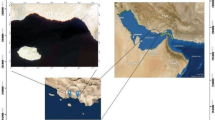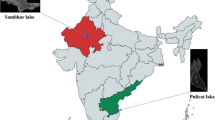Abstract
Many techniques are available for detection of shorelines from multispectral satellite imagery, but the choice of a certain technique for a particular study area can be tough. Hence, for the first time in literature, an inter-comparison of the most widely used shoreline mapping techniques such as Normalized Difference Water Index (NDWI), Modified NDWI (MNDWI), Improved Band Ratio (IBR) Method, and Automatic Water Extraction Index (AWEI) has been done along four different coastal stretches of India using multitemporal Landsat data. The obtained results have been validated with the high-resolution images of Cartosat-2 (panchromatic) and multispectral images from Google Earth. Performance of the above indices has been analyzed based on the statistics, such as overall accuracy, kappa coefficient, user’s accuracy, producer’s accuracy, and the average deviation from the reference line. It is observed that the performance of NDWI and IBR techniques are dependent on the physical characteristics of the sites, and therefore, it varies from one site to another. Results indicate that unlike these two indices, the AWEI algorithm performs consistently well followed by MNDWI irrespective of the land cover types.







Similar content being viewed by others
Explore related subjects
Discover the latest articles, news and stories from top researchers in related subjects.References
Alesheikh, A. A., Ghorbanali, A., & Nouri, N. (2007). Coastline change detection using remote sensing. International Journal of Environmental Science & Technology, 4(1), 61–66.
Boak, E.H. and Turner, I.L.( 2005). Shoreline definition and detection: a review. Journal of coastal research, 21(4), 688–703.
Chander, G., Markham, B. L., & Helder, D. L. (2009). Summary of current radiometric calibration coefficients for Landsat MSS, TM, ETM+, and EO-1 ALI sensors. Remote Sensing of Environment, 113(5), 893–903.
Davranche, A., Lefebvre, G., & Poulin, B. (2010). Wetland monitoring using classification trees and SPOT-5 seasonal time series. Remote Sensing of Environment, 114(3), 552–562.
Demirkesen, A. C., Evrendilek, F., & Berberoglu, S. (2008). Quantifying coastal inundation vulnerability of Turkey to sea-level rise. Environmental Monitoring and Assessment, 138(1–3), 101–106.
Du, Z., Li, W., Zhou, D., Tian, L., Ling, F., Wang, H., Gui, Y., & Sun, B. (2014). Analysis of Landsat-8 OLI imagery for land surface water mapping. Remote Sensing Letters, 5(7), 672–681.
Duan, Z., & Bastiaanssen, W. G. M. (2013). Estimating water volume variations in lakes and reservoirs from four operational satellite altimetry databases and satellite imagery data. Remote Sensing of Environment, 134, 403–416.
Feng, Y., Liu, Y., & Liu, D. (2015). Shoreline mapping with cellular automata and the shoreline progradation analysis in Shanghai, China from 1979 to 2008. Arabian Journal of Geosciences, 8(7), 4337–4351.
Feyisa, G. L., Meilby, H., Fensholt, R., & Proud, S. R. (2014). Automated Water Extraction Index: a new technique for surface water mapping using Landsat imagery. Remote Sensing of Environment, 140, 23–35.
Fletcher, C. H., Romine, B. M., Genz, A. S., Barbee, M. M., Dyer, M., Anderson, T. R., Lim, S. C., Vitousek, S., Bochicchio, C., & Richmond, B. M. (2011). National assessment of shoreline change: historical shoreline change in the Hawaiian Islands. US Geological Survey Open-File Report, 1051, 55.
Hui, F., Xu, B., Huang, H., Yu, Q., & Gong, P. (2008). Modelling spatial-temporal change of Poyang Lake using multitemporal Landsat imagery. International Journal of Remote Sensing, 29(20), 5767–5784.
INCOIS. (2009). Report on use of satellite data for detection of violation of land use along the coastal regulation zone and impact of port structures on shoreline changes. Hyderabad: Indian National Centre for Ocean Information Services.
Jiang, H., Feng, M., Zhu, Y., Lu, N., Huang, J., & Xiao, T. (2014). An automated method for extracting rivers and lakes from Landsat imagery. Remote Sensing, 6(6), 5067–5089.
Kuleli, T., Guneroglu, A., Karsli, F., & Dihkan, M. (2011). Automatic detection of shoreline change on coastal Ramsar wetlands of Turkey. Ocean Engineering, 38(10), 1141–1149.
Louati, M., Saïdi, H., & Zargouni, F. (2015). Shoreline change assessment using remote sensing and GIS techniques: a case study of the Medjerda delta coast, Tunisia. Arabian Journal of Geosciences, 8(6), 4239–4255.
Lucrezi, S., Schlacher, T. A., & Walker, S. (2009). Monitoring human impacts on sandy shore ecosystems: a test of ghost crabs (Ocypode spp.) as biological indicators on an urban beach. Environmental Monitoring and Assessment, 152(1–4), 413–424.
ManiMurali, R., Ankita, M., Amrita, S., & Vethamony, P. (2013). Coastal vulnerability assessment of Puducherry coast, India, using the analytical hierarchical process. Natural Hazards and Earth System Sciences, 13(12), 3291–3311.
McFeeters, S. K. (1996). The use of the Normalized Difference Water Index (NDWI) in the delineation of open water features. International Journal of Remote Sensing, 17(7), 1425–1432.
Mishra, N., Haque, M. O., Leigh, L., Aaron, D., Helder, D., & Markham, B. (2014). Radiometric cross calibration of Landsat 8 operational land imager (OLI) and Landsat 7 enhanced thematic mapper plus (ETM+). Remote Sensing, 6(12), 12619–12638.
Misra, A., & Balaji, R. (2015). Decadal changes in the land use/land cover and shoreline along the coastal districts of southern Gujarat, India. Environmental Monitoring and Assessment, 187(7), 1–13.
Misra, A., Murali, R.M., Sukumaran, S. and Vethamony, P.(2014). Seasonal variations of total suspended matter (TSM) in the Gulf of Khambhat, west coast of India. Indian Journal of Marine Sciences, 43(7), 1202–1209.
Natesan, U., Thulasiraman, N., Deepthi, K., & Kathiravan, K. (2013). Shoreline change analysis of Vedaranyam coast, Tamil Nadu, India. Environmental Monitoring and Assessment, 185(6), 5099–5109.
Otsu, N. (1979). A threshold selection method from gray-level histograms. IEEE Transactions on Systems, Man, and Cybernetics, 9(1), 62–66.
Ozturk, D., & Sesli, F. A. (2015). Shoreline change analysis of the Kizilirmak Lagoon Series. Ocean & Coastal Management, 118, 290–308.
Padman, L. and Erofeeva, S. (2005). Tide model driver (TMD) manual, version 1.2. Earth & Space Research, Seattle, Wash. Available at www.esr.org/polar_tide_models/README_TMD.pdf. Accessed 7 Nov 2015.
Pardo-Pascual, J. E., Almonacid-Caballer, J., Ruiz, L. A., & Palomar-Vázquez, J. (2012). Automatic extraction of shorelines from Landsat TM and ETM+ multi-temporal images with subpixel precision. Remote Sensing of Environment, 123, 1–11.
Rao, M. J., Greeshma Gireesh, A. G., Avatharam, P., Anil, N. C., & Karuna Karudu, T. (2012). Studies on coastal geomorphology along Visakhapatnam to Bheemunipatnam, East Coast of India. Journal of Indian Geophysical Union, 16(4), 179–187.
Rogers, A. S., & Kearney, M. S. (2004). Reducing signature variability in unmixing coastal marsh Thematic Mapper scenes using spectral indices. International Journal of Remote Sensing, 25(12), 2317–2335
Rokni, K., Ahmad, A., Selamat, A., & Hazini, S. (2014). Water feature extraction and change detection using multitemporal Landsat imagery. Remote Sensing, 6, 4173–4189.
Romine, B. M., & Fletcher, C. H. (2012). A summary of historical shoreline changes on beaches of Kauai, Oahu, and Maui, Hawaii. Journal of Coastal Research, 29(3), 605–614
Sanilkumar, V., Pathak, K. C., Pednekar, P., Raju, N. S. N., & Gowthaman, R. (2006). Coastal processes along the Indian coastline. Current Science, 91(4), 530–536.
Solecki, W. and Rosenzweig, C. (2012). US cities and climate change: urban, infrastructure, and vulnerability issues, Technical Input Report Series, US National Climate Assessment.
Sun, F., Sun, W., Chen, J., & Gong, P. (2012). Comparison and improvement of methods for identifying waterbodies in remotely sensed imagery. International Journal of Remote Sensing, 33(21), 6854–6875.
Xu, H. (2006). Modification of normalised difference water index (NDWI) to enhance open water features in remotely sensed imagery. International Journal of Remote Sensing, 27(14), 3025–3033.
Zhai, K., Wu, X., Qin, Y., & Du, P. (2015). Comparison of surface water extraction performances of different classic water indices using OLI and TM imageries in different situations. Geo-spatial Information Science, 18(1), 32–42.
Acknowledgments
The authors would like to thank the anonymous reviewers for their constructive comments. Authors sincerely thank the United States Geologic Survey and Google Earth for providing the images free of cost.
Author information
Authors and Affiliations
Corresponding author
Additional information
Highlights
• Comprehensive inter-comparison of the most widely used remote sensing-based simple and robust shoreline mapping techniques
• A first of its kind inter-comparison study for shoreline mapping at various coastal stretches of India
• Automated Otsu clustering technique for NDWI and MNDWI indices to avoid subjectivity
An erratum to this article is available at http://dx.doi.org/10.1007/s10661-017-6046-8.
Rights and permissions
About this article
Cite this article
Sunder, S., Ramsankaran, R. & Ramakrishnan, B. Inter-comparison of remote sensing sensing-based shoreline mapping techniques at different coastal stretches of India. Environ Monit Assess 189, 290 (2017). https://doi.org/10.1007/s10661-017-5996-1
Received:
Accepted:
Published:
DOI: https://doi.org/10.1007/s10661-017-5996-1




